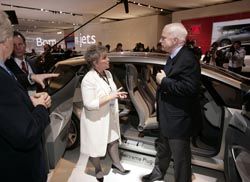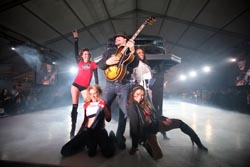- Creative Technology provided production support for GM during the North American International Auto Show. Kid Rock was on hand to perform at the Detroit Show.One of the world's biggest roaming road shows is the Auto Show. Held in cities throughout the U.S., the event serves as one of the most important marketing tools for the auto industry by introducing everything from new models to future concept cars. To successfully achieve maximum launch excitement in a very competitive environment, carmakers employ a Hollywood-styled approach that draws as much from the entertainment community as it does from the automotive industry.
- Fittingly beginning in Los Angeles, the road show moved on to various other cities and then to the North American International Auto Show in Detroit for its biggest revue and what is widely regarded as a global barometer of political, industrial, and innovation competitiveness. With so much riding on the Detroit show, automotive companies will invest heavily in projecting the right message with the appropriate level of showbiz flair at the show.
- The challenge for audio system designers and providers is to deliver systems that can go beyond simple voice reinforcement to provide concert quality sound deployed in a way that is flexible enough to accommodate different locales. Creative Technology provided General Motors with a sound system throughout the show and went through a rigorous evaluation process to determine the correct approach.
- The audio challenge is complicated by the multitude of brands under the GM umbrella, each vying for attention from different points in the same booth. Creative Technology assembled the system in response to a specification from event sound designer Jim Risgin of OSA International. "We chose JBL VP Series because it features integrated efficient power," advised Tom Miller, system design engineer for Creative Technology. "And, it could be controlled through a processing system like BSS Soundweb London Blu80s with the advanced maturity of interconnectivity required for integration with all the other products being used, plus it sounds good."
- The project, featuring 174 JBL VP Series loudspeakers, represented one of the largest deployments of this loudspeaker series. Form factor was important as well, so the Detroit design called for VP Series as the main system with VRX added for multimedia support due to versatility in application, like being used in the press area. These include VP7212-95DPCN powered 12 inch 2-way integrated loudspeaker systems supported by JBL VRX 918S subwoofers. This added up to a lot of speakers in a relatively small space, which is why fully integrated control is vital. The JBL VP Series cabinets also plugged directly into the network, allowing operators discreet assignability of each speaker. This permits engineers and operators to manipulate individual speakers at the fringes of zones in the massive, distributed loudspeaker system to control spillover and other factors.
The project, featuring 174 JBL VP Series loudspeakers, represented one of the largest deployments of this loudspeaker series.
The network is set up with discrete and redundant audio and control networks. Harman's HiQnet System Architect software, over standard TCPIP protocol, coordinates those redundant systems and the interconnection with the control system. The BSS Soundweb London Blu80s handle the front end processing with Blu32s adding I/O extensions.
"We had one approach for the LA show," said William Nealie, director of audio services, Creative Technology. "There we used high performance JBL Professional VRX loudspeakers. But with the addition of Harman HiQnet in the design for the Detroit event, the network capability of the JBL VP Series powered speakers became especially important."

The GM booth had numerous brands and was a large collection of multiple turntable platforms on which the cars rested and from which the presenters spoke using wireless lavaliere microphones. Here, presidential candidate John McCain checks out a floor model.
To help coordinate this activity within a zoned approach, the system had the ability to automatically duck audio. When the presenters stepped onto the turntable and turned on their belt pack and started speaking, it triggered the BSS Soundweb London to duck the program audio that's been running. If the presenters stopped speaking for more than 15 seconds, the audio automatically faded back in.
The system had to accommodate the clear definition of zones to coordinate this kind of automation as zone control is critical to avoid overspill. This is true not only within the GM booth from one brand to another, but required system audio design and careful speaker placement to avoid spill over to the aisle and adjacent manufacturers' booths. Loudspeaker placement had to be well thought out in focusing the image; yet, mounting became a challenge as each venue has its own idiosyncrasies. In Detroit, weight isn't an issue, whereas the trim height is.
Miller further noted that because of the raised platforms and height of the booth, multiple level soffit design and the lower ceiling in Detroit, the trim height became a complex question.
"For imaging, we usually tried to localize the audio support around the perimeter of the turntables, but the weight and trim height presented challenges in Detroit, so we applied the mounting on the lighting truss structure close to the steel of the ceiling," he stated. "Also, logistically, the tables intersect with the structure so you couldn't always put them in a targeted location. The answer was to use a distributed system. In addition to the logistics, GM wanted consistency throughout so that the media feels like one entity over the entire booth, which also dictates a distributed approach."
Logic filters were used to change the image focus from directly over the turntable to the overall booth. Even coverage of the space was created by using a down-firing speaker mounting spread above the booth. Due to reflection issues and acoustical considerations, the speakers do not fire directly vertically down to avoid splash from the floor back to the speakers. Here the JBL VP Series helped as well.
That level of performance and integration allowed this audio system to travel the Auto Show circuit adapting to whatever needs cropped up in each location. True to Hollywood form, the GM booth at the Detroit Auto Show featured some stunning performances by Mary J Blige, Kid Rock, DJ Samantha Ronson, and Maroon 5. The right technology married with the right design equals great performance and a well-received product. Hmm, sounds like a car commercial.










